Why the Pay Gap Matters
The Impact of Gender Disparities in the Workplace on Hastings and the Nation
Eleanor Roosevelt visits a female machine operator. November, 1942. Source: https://www.loc.gov/resource/ppmsca.01946/
October 27, 2021
The gender pay gap—the gap between the average salaries for men and the average salaries for women performing the same work—has refused to budge significantly since 2015. According to the Pew Research Center, American women sixteen years of age and older earned only 84% of what men earned in 2020 (up from 83% in 2015). Similarly, 17% more women than men report being treated as though they were not competent, and 11% more women report experiencing small, repeated slights at work.
Because the American workforce is so gargantuan, the history of gender disparity is a hugely impactful aspect of the nation’s culture. Although Susan B. Anthony raised the issue in 1869—“Join the union, girls, and together say, ‘Equal Pay for Equal Work!’”—concrete data about the disparity first appeared in the 1950s. In 1950, only 33% of women 18-64 were employed. (Those in the other 67% were almost certainly performing unpaid work at home.) Women who did receive a wage earned far less than their male counterparts: in the mid-1950s, women earned on average only about 60% of what men earned.
There is no definitive time when the gap started to shrink, but it began to close during the 1970s. The Women’s Liberation Movement—a concentrated effort to change the role of women in work and society—catalyzed this change. As writer Renee Blakkan wrote in 1974, “The millions of secretaries, file clerks, stenographers, key-punch operators, typists, book-keepers, cashiers, receptionists, and others may be on the threshold of a new era.”
In Hastings-on-Hudson, women became entrepreneurs and opened their own businesses around this time. According to documents from the Hastings Historical Society, women began opening storefronts in downtown Hastings in the 1970s; Leah Fischer, who opened Pot Holder, a kitchenware store, in 1971, was the first to do so. The next year, Blanche Marchetti opened Food for Thought, an organic store that still operates today. Notably, a group of Hastings women started The Enterprise, a successful newspaper covering the Rivertowns area, in 1975. In the words of the Hastings Historical Society, “[These women] transformed downtown Hastings from a male-dominated merchant culture to the more inclusive environment we experience today.”
While female-owned businesses arrived in the 1970s, changes in education and how it sets women up for professional success in careers traditionally dominated by men have also had an impact.
Mrs. Thompson, a member of the Science Department, remembers the effects of this change: “One of my fondest memories occurred at a parent teacher conference. Two parents thanked me for inspiring their girls to pursue careers in science. I had both of their older daughters in class a few years prior. The parents told me that their daughters’ love of science had grown in my class. What an incredible compliment! Both daughters had gone on to study science in college and pursue science careers.”
The change since the 1970s is apparent in statistical data. From 1950 to 2001, the percent of working women ages 18 to 64 rose from 33% to 69%. The pay gap shrunk from 64 cents to the male dollar in 1980 to about 85 cents in 2018, according to the Pew Research Center (it is worth noting that the gap was actually measured as 80.5 cents by the Census Bureau only a year earlier).
Crucially, however, this change was nowhere near comprehensive. The pay gap for Black women is still devastatingly large. 2019 Census data shows that Black women earned 63% of what white men earned, meaning that the gap for Black women is only three percentage points smaller than the gender pay gap overall in the 1950s. Gender discrimination is till rampant: in 2017, the Pew Research Center reported that four in ten women experienced gender discrimination at work.
Mrs. Rudolph, a member of the English department, recalls the impact of gender discrimination on her early experiences: “At my first job at a pizzeria, I was harassed constantly but [I was] too young and too frightened to tell anyone.” This discrimination continued in her professional life: “About 10 years ago, I applied for a job in a prestigious Westchester district, and after my demo lesson, the principal asked me what I was currently reading. When I told him that I had just finished Water for Elephants, which I enjoyed, he retorted that it was ‘a clear chick choice.’”
The pay gap is not simply about the resulting financial burden on female workers, significant as that is (in 2020, the Pew Research Center estimated that the pay gap costs women an average of 42 days worth of pay yearly). The gap is a matter of respect and dignity. Equal pay signifies respect, and modern American women, especially women of color, suffer from a serious lack of respect.


















